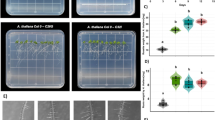Abstract
Pituranthos triradiatus (Umbelliferae) in the Negev desert of Israel is rarely grazed and when grazing occurs, it is mostly confined to sprouts. It was hypothesized that furocoumarins accumulating in the older shoots acted as natural protectants against grazing. This was tested using hyrax (Procavia capensis syriaca) for bioassay. This diurnally active herbivore is known to be resistant to various poisonous plants.
Tests were conducted in the autumn (November) and summer (June). In November starved hyraxes were offered unlimited amounts of thawed, previously frozen old branches ofP. triradiatus. They consumed an average amount of 3.4 g dry matter/kg body wt. The animals preferred to stay in the sun, and 3–4 hr after feeding, they showed severe photosensitization symptoms: apathy, photophobia, and injuries around the eyes and on the back. During the following 20 hr, four of the five treated animals died. In the second test, the effect of old branches, compared with young ones was evaluated in sunlight and under shade. Only animals that had eaten old branches and had been left in the sunlight developed photosensitization symptoms. Animals offered old shoots consumed smaller amounts than those offered young ones. However, they ingested larger amounts of imperatorin and isoimperatorin. It is suggested that these two furocoumarins induced photosensitization. Under all conditions, the hyraxes ate very small amounts of shoots ofPituranthos, compared with the amount of their usual diet. This suggests the presence of a severe deterrent factor, possibly furocoumarins, in the shoots. Since furocoumarins undergo light-induced cross-linking with DNA strands, it is conjectured that these natural protectants are segregated from regions within the plant where mitosis occurs, and this is why young shoots ofPituranthos contain smaller amounts of furocoumarins and are more susceptible to various herbivores than are old ones.
Similar content being viewed by others
References
Ashkenazy, D., Friedman, J., andKashman, J. 1983. The furocoumarin composition ofPituranthos triradiatus.Planta Medica 47:218–220.
Berenbaum, M. 1978. Toxicity of a furanocoumarin to army worms: A case of biosynthetic escape from insect herbivores.Science 201:532–534.
Binns, W., James, L.F., andBrooksby, W. 1964.Cymopterus watsonii: A photosensitizing plant for sheep.Vet. Med. Small Anim. Clin. 59:375–379.
Egyed, M.H., Shlosberg, A., Eilat, A., Cohen, U., andBeemer, A. 1974. Photosensitization in dairy cattle associated with ingestion ofAmmi majus.Ref. Vet. 31:128–131.
Egyed, M.N., Shlosberg, A., Eilat, A., andMalkinson, M. 1975. Acute and chronic manifestations ofAmmi majus induced photosensitization in ducks.Vet. Rec. 97:198–199.
Eilat, A., Malkinson, M., Shlosberg, A., andEgyed, M.N. 1975. A field outbreak of photosensitization in goslings caused by the ingestionof Ammi majus.Ref. Vet. 31:83–86.
Friedman, J., andWaller, G.R. 1984. Allelopathy and autotoxicityTIBS In press.
Ivie, G.W. 1978. Toxicological significance of plant furocoumarins,in R. Keeler, K. Van Kampen, and L. James (eds.). Effects of Poisonous Plants on Livestock. Academic Press, New York.
McKey, D. 1979. The distribution of secondary metabolites within plants, pp. 56–122,in G.A. Rosenthal and D.H. Janzen (eds.). Herbivores, Their Interaction with Secondary Plant Metabolites. Academic Press, New York.
Meltzer, A. 1965.Procavia capensis syriaca. M.Sc. thesis, Department of Zoology, Tel Aviv University.
Mendelssohn, H. 1965. Breeding the Syrian hyraxProcavia capensis syriaca Schreber 1784.Int. Zool. Yearb. 5:116–125.
Sale, J.B. 1965. Hyrax feeding on a poisonous plant.East Afr. Wildl. Jr. 3:127–129.
Scott, A.I., Pathak, M.A., andMohn, G.R. 1976. Molecular and genetic basis of furocoumarin reaction.Mutat. Res. 39:29–74.
Author information
Authors and Affiliations
Rights and permissions
About this article
Cite this article
Ashkenazy, D., Kashman, Y., Nyska, A. et al. Furocoumarins in shoots ofPituranthos triradiatus (Umbelliferae) as protectants against grazing by hyrax (Procaviidea:Procavia capensis syriaca). J Chem Ecol 11, 231–239 (1985). https://doi.org/10.1007/BF00988205
Received:
Accepted:
Issue Date:
DOI: https://doi.org/10.1007/BF00988205




